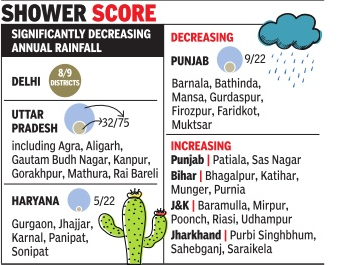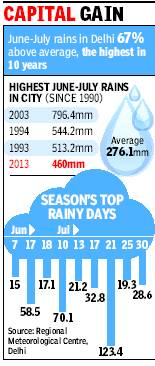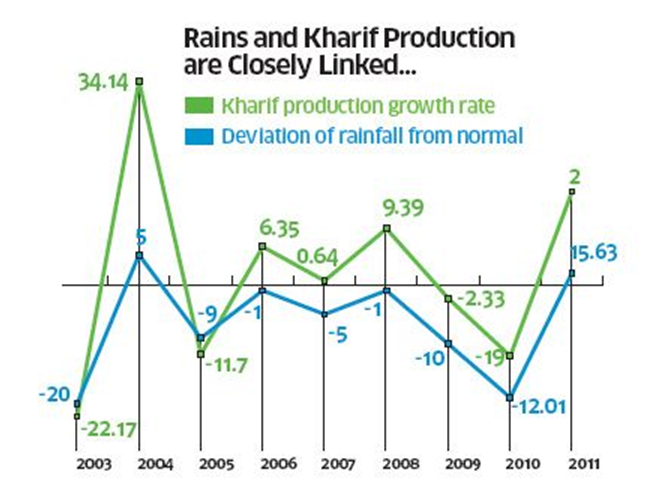Rainfall: India
(→2015: 302 of 614 districts drought affected, highest since 2009) |
(→Dry dams in west, north; overflow in south) |
||
| Line 141: | Line 141: | ||
It’s exactly the opposite down south. There, the reservoirs are overflowing. Tamil Nadu’s reservoirs now have 67% more water than in 2017. | It’s exactly the opposite down south. There, the reservoirs are overflowing. Tamil Nadu’s reservoirs now have 67% more water than in 2017. | ||
| + | |||
| + | === Civil Lines very wet, Mayur Vihar dry=== | ||
| + | [https://epaper.timesgroup.com/Olive/ODN/TimesOfIndia/shared/ShowArticle.aspx?doc=TOIDEL%2F2018%2F09%2F21&entity=Ar00112&sk=0B17A168&mode=text Amit Bhattacharya, Delhi’s monsoon: Civil Lines very wet, Mayur Vihar dry, September 21, 2018: ''The Times of India''] | ||
| + | |||
| + | |||
| + | The monsoon was normal in the capital in 2018, but how much rain did your locality get? The answer will depend on where you stay. If you are a Mayur Vihar resident, for instance, the monsoon was poor for you — 450mm since June 1, 27% below normal. But just 15km away, a Civil Lines resident had good reason to think the rains this year were excessive. The area has got 741mm of rain, 20% above normal. | ||
| + | |||
| + | Welcome to the vagaries of rainfall distribution. Even in a relatively small area like Delhi and its satellite cities, rains have been far from even. IMD’s district-wise rainfall data reveals a highly variable picture, ranging from 20% excess monsoon in north Delhi to a 45% shortfall in Ghaziabad. | ||
| + | |||
| + | Consider Gurgaon and its adjoining areas. While the Millennium City can feel shortchanged this monsoon, having got just 337mm of rain with a deficit of 26%, neighbouring Vasant Kunj and Dwarka have received more than double that amount of rainfall — 684mm, 11% above normal. | ||
| + | |||
| + | |||
| + | '''Met explains why your area got rain, your friend’s didn’t''' | ||
| + | |||
| + | Met officials said such high differences in rainfall weren’t out of line. “These differences aren’t abnormal. Rainfall is the most variable weather parameter. The smaller the area under study, the larger is the variation likely to be,” said B P Yadav, head of IMD’s Regional Meteorological Centre. | ||
| + | |||
| + | This year, several close by areas got vastly different amounts of rain over the season. For instance, the New Delhi district housing places such as Jor Bagh, Lodhi Colony and the Lutyens’ Bungalow Zone had a fairly wet monsoon (589mm, deficit of -4%) but the central district, including areas like Daryaganj, Paharganj and Karol Bagh, was considerably drier. The district has a 24% deficit, having received 472mm of rain. | ||
| + | |||
| + | Explaining such high divergence, Met officials said rainfall is rarely evenly distributed, even during spells of widespread rain. “In the beginning of this month, the Ridge observatory in north Delhi recorded heavy rainfall for twothree days while several other stations in the city hardly had any rain,” the official said. | ||
| + | |||
| + | For the record, the north Delhi district — IMD goes by the old demarcation of districts in which north includes places such as Rajpur Road, Shamnath Marg, Civil Lines and DU’s north campus — was the wettest this season in the city. The driest district was east (Mayur Vihar, Preet Vihar, Patparganj etc). Among Delhi’s neighbouring cities, Ghaziabad was the driest having received just 337mm of rain through the season. Overall, Delhi has an 8% monsoon deficit, well within the normal range (+20 to -20%). | ||
| + | |||
| + | However, questions could be asked on the quality of the district-wise data, particularly since the Met department does not have working rain gauges in all districts. An official said weather stations at Akshardham and DU were not working. | ||
| + | |||
| + | “Many of the automatic weather stations in the city were set up during the Commonwealth Games. These came up close to spots associated with the Games. These locations are not always ideal for capturing district-wise rain data,” an official said, not wishing to be named. | ||
| + | |||
| + | The north Delhi district was the wettest this season in the city. The driest district was east. Overall, Delhi has an 8% monsoon deficit, well within the normal range (+20 to -20%) | ||
=Rainfall and the kharif crop= | =Rainfall and the kharif crop= | ||
Revision as of 06:25, 30 September 2018
This is a collection of articles archived for the excellence of their content. |
Rainfall over the years
1961-2013: falling rainfall trend in north India
North India may have enjoyed a bountiful monsoon so far this year but long-term rainfall data points to a worrying trend. An India Meteorological Department (IMD) analysis reveals several parts of the region have been witnessing decreasing annual rainfall over the past five decades.
Delhi and NCR cities such as Gurgaon and Noida such as Gurgaon and Noida are among 85 districts across the country , constituting 8% of India's area, where a “significantly decreasing“ rainfall trend has been observed since 1961.
The decreasing trend was most pronounced in north India, which has more than 50 of these districts, many in agriculturally important belts.
The IMD study ana lysed annual and seasonal rainfall trends in 632 districts and 34 meteorological sub-divisions, barring Ladakh, Andaman & Nicobar and Lakshadweep islands, using rainfall data from 1901 to 2013. Uttar Pradesh finds it self with more than 40% (32 out of 75) of its districts showing a significant drop in rainfall. In Delhi, eight of the nine (old) districts showed the trend.
An IMD scientist involved in the analysis told TOI that while researchers found no trend in countrywide rainfall during the periods studied, subdivision and district-wise trends were apparent. “The aim of the study was to implement suitable measures and en sure proper management of water resources in districts that have shown decreasing rainfall,“ the scientist said.
More recent data outside the study, too, reveals a weakening of the monsoon in several parts of north India. The trend is sharpest since 1999. Of the 18 rainy seasons during this period, Haryana received at least 10% below normal monsoon in 13 years. For Punjab, the corresponding figure was 12. Decreasing rainfall has obvious impacts on levels of groundwater, which is increasingly being used in agricul ture as well as cities in the region. Satellite studies have revealed alarming levels of over exploitation of ground water in north India.
The IMD study also revealed an increasing rainfall trend in several districts, including many in Jammu & Kash mir and Bihar, and a few in Jharkhand, Punjab and Chhattisgarh.
Scientists involved in the study said it was difficult to pinpoint reasons for the increasing or decreasing trends. An expert at the Indian Institute of Tropical Meteorology reasoned that monsoon circulation had been showing a weakening trend since the 1950s, possibly due to anthropogenic influences like pollution aerosols. “Indo-Gangetic plains are a core monsoon area, where the monsoon trough is located. The weakening of the monsoon circulation may have had its impact on this region too,“ he said.
1961-2013: Pune bucks trend of 85 districts
Despite being a rain shadow region, Pune is the only district in Maharashtra where yearly rainfall has increased significantly since 1961 though close to 85 districts in the country, including in Delhi, Haryana, Uttar Pradesh and Madhya Pradesh, among others, have witnessed decreasing annual rainfall during the last five decades, a recent analysis by India Meteorological Department (IMD) has found.
The IMD study analysed long-term trend of annual and seasonal rainfall over 632 districts and 34 meteorological sub-divisions using rainfall data from 1901 to 2013. The analysis was done barring Andaman and Nicobar and Laksh adweep islands. The analysis found that while monsoon and annual rainfall has decreased significantly in Pune from 1901 to 2013, the district's annual rainfall has increased over the recent decades -from 1961-2013.
Annual and monsoon rainfall for Mumbai suburban and Raigad, too, has decreased during the 113-year period, the study found. Conversely , from 1961 to 2013, the annual rainfall for the two coastal districts has increased, but not significantly. An IMD scientist involved in the analysis told TOI that while researchers found no trend in the country-wide rainfall during the periods studied, subdivision-wise and districtwise trends were apparent.
The analysis found that over the last five decades, subdivisions like Marathwada in Maharashtra, Punjab, Himachal Pradesh, Harayana, Delhi, Uttarakhand, west and east UP have seen a reduction in both, annual and monsoon rainfall, while Konkan-Goa has seen a significant increasing trend, followed by Madhya Maharashtra, Vidarbha, among others in the country .
1971-2010: During the La Nina years
See graphic, ' Rainfall % of average, September and June July during La Nina years: 1971-2010 '
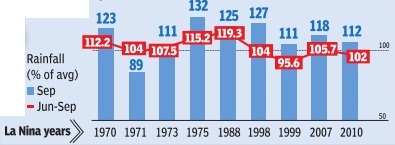
1980-2015: The driest Julys
See graphic, ' Total sown area under kharif crops 2014 and 2015…'
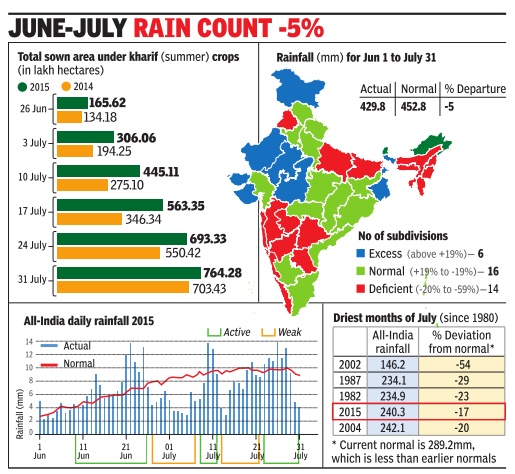
ii) The driest Julys between 1980-2015; Graphic courtesy: The Times of India, Aug 02 2015
2002-15: drought years
See graphic, '2002-15: years when India was affected by drought '
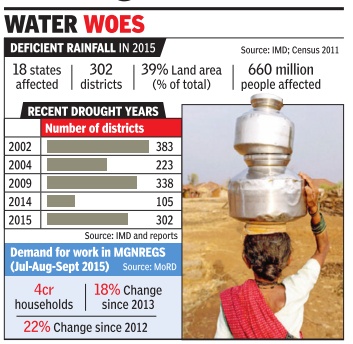
2013: Country sees wettest June-July in 19 yrs
The Times of India 2013/08/02
The June- July 2013 rainfall, which has been 117 % of the long period average [LPA] is the highest the country has seen since 1994. The last time there was more rain during this two-month period was in 1994, when the monsoon was 123% of the average. The 528.1mm rain bounty that the country got in the first half of the monsoon season is the third highest in 50 years. The wettest June-July spell during this period was in 1994 (564.7mm) while the second wettest was 1964 (538.1mm). Another interesting feature of this year’s rains has been the absence of a break in the monsoon ever since it covered the entire country in June 16.
Jun-Jul 2013: With 460mm rain, Delhi’s wettest in 10 years
Amit Bhattacharya TNN
The Times of India 2013/08/04
New Delhi: The first two months of the monsoon season have been wettest in the capital in the past 10 years. Delhi’s June-July rain tally stood at 460mm, 67% above normal, which is the second highest of this century after 2003.
The city’s rain aggregate got a huge boost in the second half of July. According to figures provided by the Regional Meteorological Centre, the capital got 238.9mm of rain during July 16-31, which is more than the average for the entire month.
There were 10 rainy days during this period, including the season’s wettest day (July 21), when 123.4mm came down on the city. This late surge lifted July’s rain tally to 340.5mm, 62% higher than the month’s average rainfall of 210.6mm. Since 1990, there have been only three years when the city has got more rain in June-July than this year. Apart from 2003, the other bountiful years were 1994 and 1993.
While the rain gods have been kind to Delhi, in neighbouring Haryana it’s been a different story. The meteorological district comprising Haryana, Delhi and Chandigarh is the only one in north India where rains have been deficient so far. That’s mainly because of poor rainfall in Haryana.
2014-18: June- August rainfall
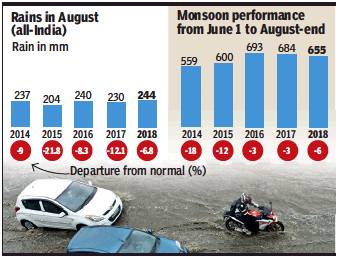
From: Neha Madaan, For India, it’s the rainiest August in five years, September 2, 2018: The Times of India
This August, India recorded the best monsoon for the month in last five years despite a 6.4% shortfall in showers in comparsion to the normal range.
The -6.4% departure is the least deficit recorded in August since 2014 – a drought year. Since 2014, the country saw departures from -8% to -21%. This year, however, all the subdivisions, except south peninsula, ended up with less than average rain in August 2018, but India fared better than all the years since 2014.
An IMD official said August had no break-like conditions this year, unlike last year and 2016. In 2017, breaklike conditions prevailed during the first week of July and on several days during the first fortnight of August. In 2017, August 3 and 4, and August 11 to 13 depicted typical monsoon-break conditions. This made August 2017 end up at a -12.1% departure from normal.
In 2016, rainfall activity was very less in June, second part of July and August, as well as in the beginning of September. Though rainfall activity was good in the beginning of July and August, the monthly rainfall in August 2016 ended with a -8.3% departure from normal.
In 2015 rainfall activity over India in August was very subdued. Except for some meteorological subdivisions of central, peninsular and extreme northeastern region, most of the subdivisions received deficient or scanty rainfall.
A K Srivastava, head of climate monitoring at IMD, Pune, said 2014 and 2015 were El Nino years, resulting in below-normal rain. “Typically, August experiences a break situation in the second or third week in most years. This year, monsoon was very active during August, so much so that it caused a deluge in Kerala. An upper air anti-cyclone in August over NE ensured westward movement of monsoon systems, causing good rainfall,” he said.
2015: July
See graphic, ' Rains in July 2015 '

2015: Lowest rainfall since 2009
The Times of India, Oct 01 2015
Neha Madaan
Monsoon ends with lowest rainfall in 6 yrs
The monsoon season ended on Wednesday with a 14% deficit, making it the weakest monsoon since 2009.In terms of average countrywide rainfall during the season (June-September), this year was the third lowest since 1979, the other acutely deficient year being 2002. The country received 760.6mm rainfall during the June-September monsoon season as against the normal 887.5 mm, which is less than last year's monsoon performance of 781.7mm. With this, the country has seen two backto-back droughts, the first since 1986-1987.
In September, despite a few late spells of rain in several parts of the country including deficit regions such as central Maharashtra, Marathwada, south peninsula and northwest India, the total rainfall was the lowest since 2005. The country received 131.4mm rainfall in September this year, 24% less than the normal and the lowest in the past 11 September months. In 2002 and 2009, the two worst drought years the country experienced in recent decades, the rainfall deficiency stood at 19.2% and 21.8%, respectively . The India Meteorological Department has, however, discontinued using the term “drought“ because it believes an entire country never faces a drought.
2015: 302 of 614 districts drought affected, highest since 2009
The Times of India, Oct 03 2015
Subodh Varma
302 of 614 districts reeling under drought, highest since 2009
There is more to this year's rainfall deficit than meets the eye. After the monsoon was officially declared over on September 30, 17 of the country's 36 weather subdivisions had received deficient or scanty rainfall. That's about 39% of the country's area, home to over 66 crore people, nearly half the country's population. Deficient is when rains are below the average by 20% or more while scanty is when it's below 50%.
Deficient or scanty rains have affected people in 302 districts out of 614 that have sent in their rainfall data to the Indian Meteorological Department (IMD). Details of some 27 districts mainly are yet to come in. Eighteen out of 36 states and union territories are affected. Some of the top grain producing states like Punjab, Haryana, UP , MP and Bihar are part of this belt.These are also areas of high population density , and high dependence on agriculture.Considering the gigantic scales involved in this drought, it is surprising that not much alarm or preparation is visible at the policy makers' level.
The last time a drought of this scale was witnessed was in 2009 when 338 districts were affected. In 2002, 383 districts were drought stricken. In 2014 the number of districts affected by deficient rains was 105.
There are other worrying indicators also. In the 91 big reservoirs in the country , current water storage is 61% of their total live storage capacity, according to the latest data from the Central Water Commission (CWC). This is significantly lower than the 10-year average of 77% storage. In the southern region live storage is just 34% of capacity compared to average 81% for the last decade. In the coming days when this reservoir stored water will need to be used for irrigation, power generation and drinking, this shortage will come into play . It will also mean additional pressure on an already overdrawn ground water reserves.
Food grain stocks were 509 lakh metric tons (LMT) on September 1 this year, lower by 15% over the 602 LMT stock last year. This is not because of the monsoon but probably due to the 4.7% dip in grain production last year and only a nominal increase in the minimum support price offered by the government to the farmers. But low stocks is worrying because this is what is going to be consumed till the kharif harvest comes in.
So, what about the kharif crop that was sown in this monsoon? According to the first advance estimates by the government, the hope is that kharif production will be 124 million tons. This is mainly rice, pulses and coarse grains.Last year, kharif production was 126.3 million tons. So that's a shortfall of 2%.
But experts say that these first estimates are based on sowing of crops. How the standing crop fared in its life is what determines how much food grain it provides. It is here that the current drought's peculiarities will matter.
In June this year, rainfall was 16% higher than the long period average. This led to hopes of a good monsoon.So, sowing was done vigorously.But then the rainfall plummeted.
2018
Dry dams in west, north; overflow in south
September 16, 2018: The Times of India
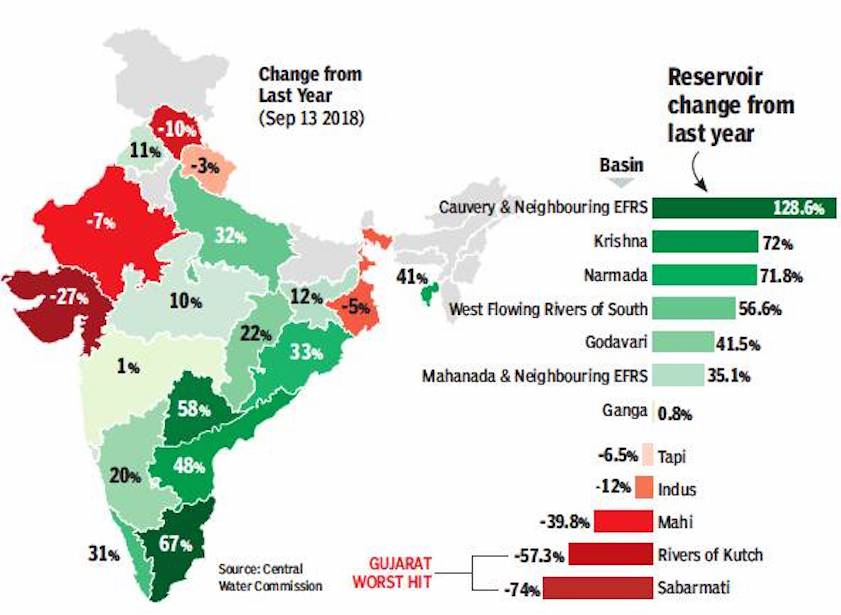
From: September 16, 2018: The Times of India
June was a good month: monsoon hit Kerala on time and most of the country, barring four states, got decent rain. By mid-June, rainfall was actually 20% in excess. Things got choppy after that – heavy rain in parts, deficit in others. So, by August 8, there was a 10% deficit. This shrunk to 6% by end of the month, but by September 11, deficit was up to 8%.
All this, coupled with how it has rained in the previous years, led to some reservoirs running dry while some are overflowing. Gujarat has been among the worst hit, with reservoirs linked to river Sabarmati 74% drier than last year.
It’s exactly the opposite down south. There, the reservoirs are overflowing. Tamil Nadu’s reservoirs now have 67% more water than in 2017.
Civil Lines very wet, Mayur Vihar dry
The monsoon was normal in the capital in 2018, but how much rain did your locality get? The answer will depend on where you stay. If you are a Mayur Vihar resident, for instance, the monsoon was poor for you — 450mm since June 1, 27% below normal. But just 15km away, a Civil Lines resident had good reason to think the rains this year were excessive. The area has got 741mm of rain, 20% above normal.
Welcome to the vagaries of rainfall distribution. Even in a relatively small area like Delhi and its satellite cities, rains have been far from even. IMD’s district-wise rainfall data reveals a highly variable picture, ranging from 20% excess monsoon in north Delhi to a 45% shortfall in Ghaziabad.
Consider Gurgaon and its adjoining areas. While the Millennium City can feel shortchanged this monsoon, having got just 337mm of rain with a deficit of 26%, neighbouring Vasant Kunj and Dwarka have received more than double that amount of rainfall — 684mm, 11% above normal.
Met explains why your area got rain, your friend’s didn’t
Met officials said such high differences in rainfall weren’t out of line. “These differences aren’t abnormal. Rainfall is the most variable weather parameter. The smaller the area under study, the larger is the variation likely to be,” said B P Yadav, head of IMD’s Regional Meteorological Centre.
This year, several close by areas got vastly different amounts of rain over the season. For instance, the New Delhi district housing places such as Jor Bagh, Lodhi Colony and the Lutyens’ Bungalow Zone had a fairly wet monsoon (589mm, deficit of -4%) but the central district, including areas like Daryaganj, Paharganj and Karol Bagh, was considerably drier. The district has a 24% deficit, having received 472mm of rain.
Explaining such high divergence, Met officials said rainfall is rarely evenly distributed, even during spells of widespread rain. “In the beginning of this month, the Ridge observatory in north Delhi recorded heavy rainfall for twothree days while several other stations in the city hardly had any rain,” the official said.
For the record, the north Delhi district — IMD goes by the old demarcation of districts in which north includes places such as Rajpur Road, Shamnath Marg, Civil Lines and DU’s north campus — was the wettest this season in the city. The driest district was east (Mayur Vihar, Preet Vihar, Patparganj etc). Among Delhi’s neighbouring cities, Ghaziabad was the driest having received just 337mm of rain through the season. Overall, Delhi has an 8% monsoon deficit, well within the normal range (+20 to -20%).
However, questions could be asked on the quality of the district-wise data, particularly since the Met department does not have working rain gauges in all districts. An official said weather stations at Akshardham and DU were not working.
“Many of the automatic weather stations in the city were set up during the Commonwealth Games. These came up close to spots associated with the Games. These locations are not always ideal for capturing district-wise rain data,” an official said, not wishing to be named.
The north Delhi district was the wettest this season in the city. The driest district was east. Overall, Delhi has an 8% monsoon deficit, well within the normal range (+20 to -20%)
Rainfall and the kharif crop
2003-11
See graphic, ' The linkage between rainfall and the kharif crop, 2003-11 '
Regional variations
Some of India's rainiest places
See graphic, ' Some of India's rainiest places '
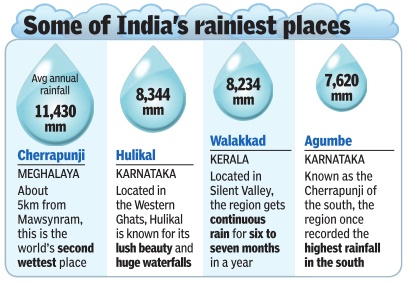
Delhi
June- Aug (average); 2018 (actual)
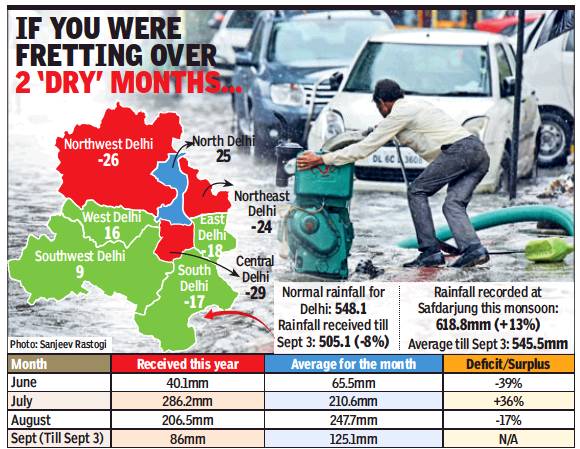
June- Aug (average); 2018 (actual)
From: Jasjeev Gandhiok, Hat-trick of rainy days in Sept helps erase deficit of 2 months, September 4, 2018: The Times of India
The capital saw two rainfall deficit months during this monsoon, but the first three days of September seem to be making up for it — Delhi now has a 13% rainfall ‘surplus’.
A Met official said that after recording a deficit of 39% in June and 17% in August, Delhi, as per the measurements by the Safdarjung observatory, has now received 618.8mm of rain in the monsoon season so far as compared to the usual average of 545.5mm.
Although the Safdarjung observatory is considered the base both in terms of rainfall and temperatures, the Met office said the overall rainfall distribution across all districts in Delhi still showed a deficit of 8% at 505.1mm as compared with the average of 548.1mm. “Central, northwest and northeast Delhi are all in the deficient zone right now, while northern Delhi has recorded a large excess. The other parts like south and southwest Delhi are close to the average,” said a Met official.
According to the India Meteorological Department (IMD), with moderate showers, September is on track to cross its monthly average of 125.1mm in this first week itself, recording around 86mm of rainfall till 8.30am on Monday. “The average for Delhi in September is around 125mm. With more rain forecast for this week, the capital could record a good surplus during this period,” said the Met official.
According to IMD data, Delhi’s Safdarjung observatory recorded just 40.1mm rain in June as compared to a monthly average of 65.5mm. However, July saw a surplus of 36% with 286.2mm rain. The monthly average for July is 210.6mm.
“But August once again had a rainfall deficit of around 17% with just 206.5mm rain recorded as compared to a normal of 247.7mm for Safdarjung. Late rainfall activities in the last week of August improved this figure. However, September so far has been extremely good for Delhi,” said an official.
On August 28, Gurgaon received the heaviest rainfall in eight years, and Delhi has seen moderate showers over the past three days. The forecast for this week shows that light-to-moderate showers are likely to continue over the entire national capital region (NCR). Rainfall is largely considered ‘deficient’ if it is under 19% of the normal, while ‘excess’ rainfall is recorded if it’s above 19%.
“Conditions right now are ideal for more rain not just over Delhi but adjoining places, too. We expect this activity to continue for at least the next three to four days,” said an official.
2018, Sept 1-10: longest wet spell since 1988
Amit Bhattacharya, September 11, 2018: The Times of India
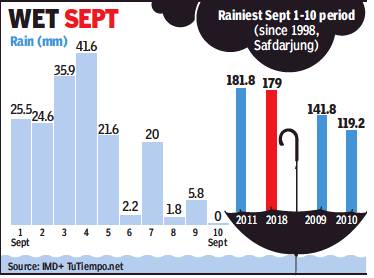
From: Amit Bhattacharya, September 11, 2018: The Times of India
The capital witnessed its longest wet spell in the month of September in 22 years, with rain being recorded in nine consecutive days from the first till the ninth of the month. Safdarjung, Delhi’s main weather station, registered 179mm of rain during these nine days, nearly 40% more than the normal for the entire month.
This was also the wettest start to September — counting the first 10 days of the month — in seven years and the second wettest in the last 22 years, according to rainfall data from IMD and the TuTiempo website.
In fact, it rained continuously in the capital from August 27 till September 9, as per Safdarjung weather station records, barring just a single day — August 31.
The next few days, however, are expected to be relatively dry in the city.
9 days of continuous rain in Sept unusual for Delhi
Safdarjung recorded as much as 259mm of rain in this 14-day period, more than what the city normally receives during the entire period of its wettest month of August. Normal August rainfall in Delhi is 247.7 mm.
“It is highly unusual for the city to record nine straight days of rainfall, particularly in September. The spell was caused by steady incursion of moisture into the region because of a persisting cyclonic circulation over Uttar Pradesh and Haryana that led to the monsoon trough staying close to the capital,” said B P Yadav, head of IMD’s regional meteorological centre.
This peculiar atmospheric condition led to long spells of rain in a relatively small area adjoining south Haryana and UP, the official said.
The monsoon trough, a typical feature of the monsoon season, is an east-west line of atmospheric low pressure that divides two regions of differing air flows. It usually moves in a northsouth direction, shuttling between the Himalayan foothills and the central Indian plateau. But during this period, officials said, the trough stayed mostly just north or south of the national capital, creating perfect conditions for rainfall over the area.
It was in 2011 that the capital last saw a wetter start to September. Then, the cumulative rainfall in the first 10 days of the month was just marginally more than this year, at 181.8mm. Going back further, such heavy rainfall in the beginning of September was last seen in the capital way back in 1995, when 179.3mm was recorded in the first 10 days of the month.
As for most consecutive rainy days in September, 2011 too saw a nine-day wet spell like this year. A longer spell was last witnessed in 1995, when 11 straight days of rain took place from September 3 to 13, as per the weather archives website, TuTiempo.net.
Gurgaon/ Gurugram
Rainfall records, 2008- 2018

See graphic, ' Gurgaon’s rainfall records, 2008- 2018 '
Punjab and Haryana
1999-2014: Rain woes in Punjab, Haryana
The Times of India, Jun 03 2015
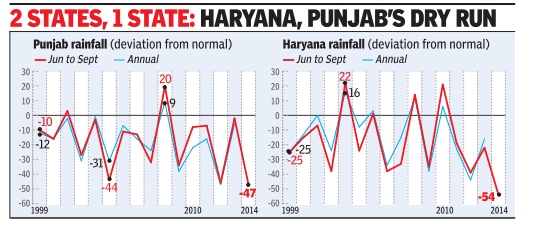
Amit Bhattacharya
SHOWER SHORTAGE - For 2 grain-bowl states, below-par rain for 16 years
IMD's monsoon update predicts 85% seasonal rains for northwest India, indicating that rain woes of the agriculturally crucial states of Punjab and Haryana could continue for another year.
Both states have witnessed meteorological droughts in five of the last 10 years, meaning rainfall in half of the past decade has been at least 25% below the long term average (LPA). Last year's monsoon season was among the driest in the recorded history of both states. Punjab received 243.5mm of rain against an LPA of 491.5mm, posting a 50% deficit for the season. It was the second worst monsoon in the state in 113 years (1901-2014), next to only the 67% deficit seen in 1987.
Haryana had an even greater deficit of 56%, with the state receiving 200.1mm rain as against an LPA of 460.3mm. Only two monsoons since 1901 have been worse in the state.
More worryingly, the distress is not limited to the past decade. The two grainbowl states, which were at the forefront of India's green revolution, have been getting below par rainfall for the past 16 years.
According to Met department figures, Punjab has seen just two above normal monsoons since 1999. The last time that happened was eight years ago, in 2008.
Haryana's plight is similar. The June-September rains in the state have been above par on just four occasions in the past 16 monsoons.
Some experts see the chronic monsoon deficien cy in the two states as the worst symptoms of a larger and natural monsoon cycle, which has been in the downswing phase in the past several decades.
Other experts TOI had spoken to when it highlighted this trend last year were of the opinion that the deficit went beyond natural monsoon variability and needed to be investigated.
Interestingly, all through this one-and-a-half decades of depressed rainfall, the ag ricultural output of the two states has been rising.
That's because farmers have been tapping deeper and deeper into the groundwater resources of the region.
According to a Central Ground Water Board report, Punjab overexploits its groundwater annually by 170%, the highest in the country . Of the 138 blocks in the state, groundwater is overexploited in 110 (80%).Haryana is not far behind, with 59% of blocks labelled overexploited.
Many studies, including those using satellite data to map the groundwater situation, have shown that such drawals were unsustainable and the region was fast reaching the limits of such overexploitation.
See also
India Meteorological Department
Rainfall: India and Burma, 1907-12
Rainfall: India
May weather in India <> June weather in India <> July weather in India <> August weather in India <> September weather in India <>
